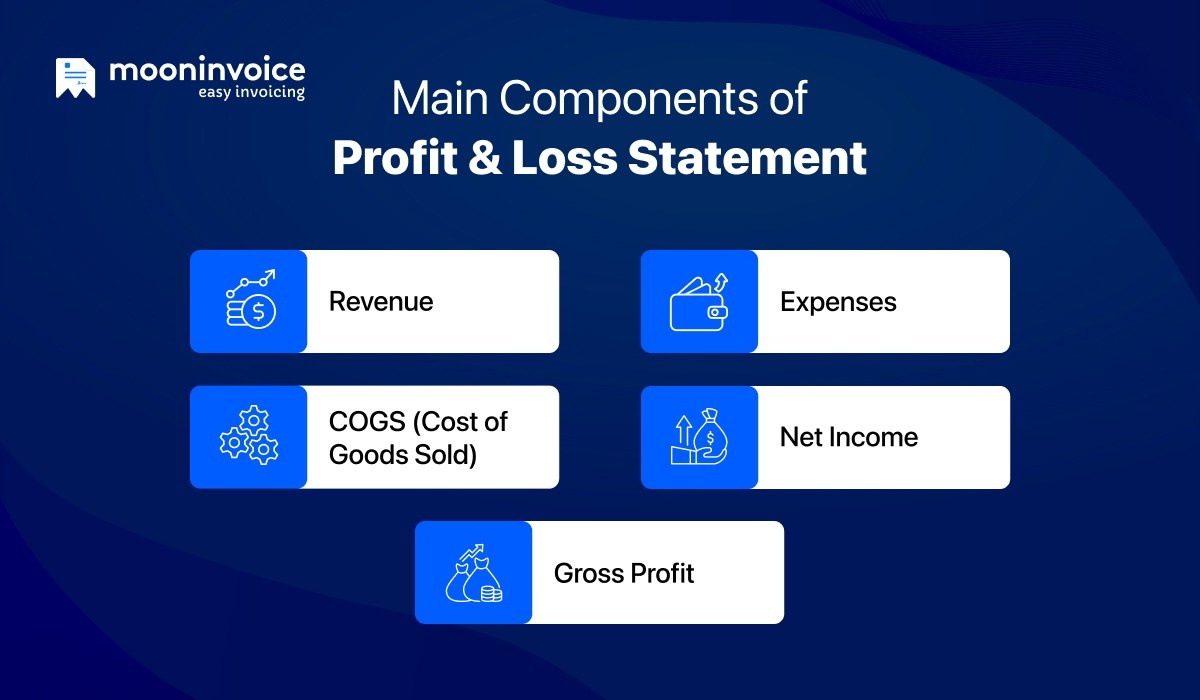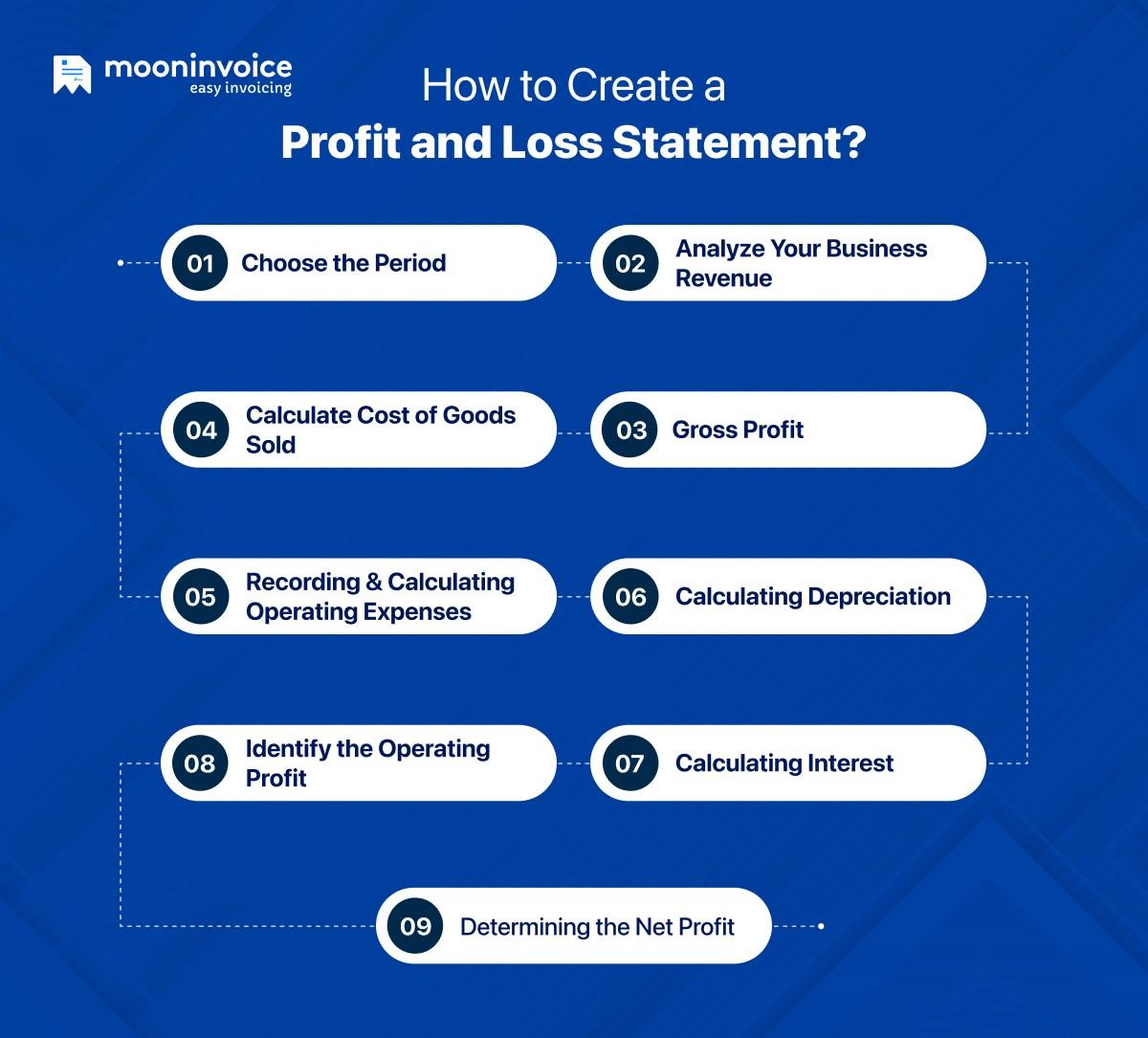Profit and Loss Definition
A profit and loss statement is a financial report that summarizes revenue, expenses, and
of the company.
What’s the financial performance of my company? As a business owner, you must be aware of this query, and the best way to find the answer is through a profit and loss statement.
A financial document that showcases a company’s financial health. You can clearly determine what net revenue & profit your business is making while spending. Ultimately, it helps to make fair decisions for achieving the goals. Apart from these, this financial report also ensures compliance with tax regulations and is helpful during tax return preparation.
However, it is unfortunate that many professionals lack a clear understanding of how to prepare a profit and loss statement. As a result, business owners often lack a clear understanding of whether their company is profitable.
Our article will provide a clear example of a profit and loss statement, along with the strategy for creating it. Additionally, you’ll learn why the P&L statement is valuable for your business. Therefore, reading this blog will be worthwhile for you.
📌 Key Takeaways
- A profit and loss statement includes information on the company’s revenues, cost of goods sold, operating expenses, and net earnings.
- It shows the net profit or loss of the business.
- The typical frequency of analysis for P&L statements is monthly, quarterly, or annually, but can be more frequent as needed by the business.
- A profit and loss statement report is equally important as a cash flow statement and the balance sheet.
- P&L statements are helpful for business owners to adjust the company’s pricing structure by analyzing financial metrics.
- A year-to-date profit and loss statement is useful for tax purposes.
What Is a Profit and Loss Statement?
A profit and loss statement (also known as an income statement) is a financial document that represents the company’s net profit, revenue, expenses, and resulting profit or loss. This report presents the company’s financial performance for the specified period. Additionally, it highlights the company’s ability to generate revenue and achieve a profit while effectively managing its expenses.
A clear & simple profit and loss statement makes it easy for you to evaluate your business performance and economic well-being. Additionally, it also attracts investors by representing your company’s potential growth. Typically, organizations should prepare a profit and loss statement on a monthly, quarterly, or annual basis.
💡Unbelievable Facts:
According to the Federal Reserve Bank of St. Louis report, a 73% increase in corporate profits has been observed across the retail, manufacturing, construction, healthcare, and wholesale trade sectors.
Profit and Loss Formula
The basic P&L formula is as follows:
Net Profit/Loss = Total Revenue – Total Expenses
This is a basic formula for a profit and loss statement. However, the detailed form covers the consideration and calculation of COGS, operating expenses, gross profit, and net operating profit.
Is a Profit and Loss Statement the Same as an Income Statement?
Profit and loss statement and income statement are identical financial reports. Both represent the financial position of the business. Additionally, both cover information about revenue, expenses, and net profit for the specific period.
How Does a Profit and Loss Statement Work?
The major purpose of a profit and loss statement is to show the company’s expenses, revenue, and profit. Business professionals should treat it equally important as the balance sheet and cash flow statement.
A typical P&I statement includes a systematic flow that begins with the total revenue at the top of the statement. Further, it shows the subtraction of the costs & expenses that the business incurs during the operation. This covers COGS, operating expenses, and applicable taxes.
After the deduction, the bottom line shows the net income that the company earns. This is a basic approach to any profit and loss sheet.
Types of Profit and Loss Statements
After learning how to create a profit and loss statement, let’s move on to its various types. There are four methods to define the P&L statement types. The first two methods are very popular.
1. Cash Method
From the name itself, it is predictable that it is solely useful when the company possesses cash transactions. Therefore, the profit and loss statement is prepared when the business generates revenue through cash inflows and records it as an expense when the company makes a cash payment. It is a common strategy among small businesses.
2. Accrual Method
The accrual accounting method involves the inclusion of revenue records just after products & services are sold. This recording is not aligned with the receipt of payment from the buyer. Similarly, expenses are recorded before paying the bill.
The choice between the cash method & accrual method depends on the business’s size and nature. The cash method is straightforward, making it ideal for small businesses. In contrast, the accrual method is good for large-scale businesses.
3. Single-Step Method
A single-step method is very simple. Here, you can easily calculate the net income by subtracting the total amount of expenses from the revenue.
Net Income = Revenue – Total Expenses
There is no further subcategorization of revenues and expenses. This method is suitable for businesses with very low expenses.
4. Multi-Step Method
Unlike the single-step method, it’s a bit complex. It separates operating and non-operating revenues and expenses into distinct categories. It gives more insights into the financial condition, including operating profit and gross profit. It involves the calculation of gross profit, operating income, and net income, which are as follows:
- Gross profit = Net sales – cost of goods sold
- Operating income = Gross profit – operating expenses
- Net income = Operating income + Non-operating items
Automate Your Tasks, Reduce Your Overhead Cost
Get started with Moon Invoice today to cut down your business overhead expenses with automation.
What Are the Main Components of a Profit and Loss Statement?

A profit and loss statement sample may vary from business to business, depending on its nature and size. However, the major components of the format are as follows:
1. Revenue
Also known as gross revenue, represents the earnings amount generated before subtracting any expenses. It is also interchangeable with sales. However, sales revenue is often referred to as the income that your company generates from its core business.
2. COGS (Cost of Goods Sold)
COGS include the costs that your company spends on product manufacturing and its sale. It covers labor cost, raw materials, inbound shipping, and other expenses. To calculate COGS, the following formulas work.
In General –
COGS = Opening Inventory + Purchases During the Period – Closing Inventory
For Manufacturing –
COGS = Direct Material + Direct Labor + Manufacturing Overhead
3. Expenses
It includes the expenditure that the company incurs for operating the business. Certain investments, such as office supplies, employee salaries, and utilities, are essential for running a business. The other expenses include business marketing, research & development, and traveling costs.
4. Gross Profit
Gross profit refers to the profit your company makes after deducting COGS from total revenue. It does not include deductions for taxes, interest payments, and operating expenses.
Gross Profit = Total Revenue – COGS
5. Net Income
The net income of the company refers to your company’s profit after deducting all taxes, expenses, interest, amortization, and COGS from the total revenue. It is also referred to as net profit, net earnings, or bottom line.
Net Income = Total Revenue – Total Expenses
Or
Net Income = Total Revenue – COGS – Operating Expenses – Interest Expenses – Taxes
How to Create a Profit and Loss Statement?

A profit and loss statement is a crucial business financial report that should be prepared along with the cash flow statement. Creating a P&L statement can be tedious with a manual approach. However, one can ease the creation process by utilizing the accounting software that helps automate most tasks.
Use the steps below as a guide on how to make a profit and loss statement:
1. Choosing the Period
Initially, you need to choose the timeframe for which you want to create your simple profit and loss statement. You have various options, including weekly, biweekly, monthly, or annual. Have proper clarity on it before stepping further in the process.
2. Analyze Your Business Revenue
Once you have decided on the above timespan, the next step is to monitor your business revenue for the same period. Note down all the revenues you earn and then add them up.
3. Calculate Cost of Goods Sold
Calculate the cost of goods sold by considering all the costs incurred in the product’s manufacturing. It includes both labor and material costs. The other indirect costs, such as office rent and overhead expenses, are exempt from it. The COGS is calculated as:
COGS = Beginning Inventory + Purchase – Ending Inventory
4. Gross Profit
Gross profit refers to the revenue that you gain after deducting the cost of creating and providing the product or the service. To calculate gross profit, you need to use the formula:
Gross Profit = Revenue – COGS
5. Recording & Calculating Operating Expenses
Operating expenses refer to the costs incurred for operating a business. You might pay office rent, utilities, insurance premiums, or loan repayments. Consider all these costs, as they are the expenses you incur to run your business.
6. Calculating Depreciation
Depreciation represents the reduction in value of a company’s assets due to wear and tear, as well as other forms of obsolescence. The company’s assets include equipment, vehicles, and other physical assets. It is recorded in the operating expense form, which reduces net profit and taxable income.
7. Identifying the Operating Profit
Operating profit is the profit you earn after deducting operating expenses and depreciation. You might get an operating loss if the operating profit is less than the operating expenses.
Operating Profit = Gross Profit – Operating Expenses – Depreciation
8. Calculating Interest & Taxes
If you have a business loan, then calculate the total interest you paid for the period. Similarly, consider all the taxes you pay from the total revenue you earn.
9. Determining the Net Profit
The bottom line of your profit and loss statement will include the net profit of your business. Calculating net profit is straightforward. Subtract taxes and all expenses from the operating profit.
👉Worth Reading:
Profit and Loss Statement Example
Previously, we have covered the steps to determine the P&L statement. Let’s gain a deeper understanding through a profit and loss example, assuming the relevant details are provided.
Suppose a company named EcoCraft Manufacturing is a manufacturing unit that generates revenue of $2,500,000 in September and $2,600,000 in October for 2025. The total operating expenses were $240,120 in September and $231,100 in October for the same year.
Calculating the operating profit, the company made $1,209,880 in September and $1,368,900 in October. The bottom line of the format shows the net profit, which is calculated by subtracting the other non-operating expenses and taxes from operating profit & non-operational income. Here is a typical profit and loss statement example.
EcoCraft Manufacturing Pvt Ltd
Monthly Income Statement
| Particulars | September | October |
|---|---|---|
| Sales/Revenue | ||
| Cost of Goods Sold | ||
| Gross Profit (Revenue-COGS) | ||
| Operating Expenses | ||
| Insurance | ||
| Marketing & Advertisement | ||
| Rent | ||
| Commission | ||
| Wages | ||
| Miscellaneous Operating Cost | ||
| Total | ||
| Operating Profit (Gross Profit – Operating Expenses) | ||
| Non-Operational Income | ||
| Interest Revenue | ||
| Non-Operating Expenses | ||
| Taxes | ||
| Net Income/Net Profit (Operating Profit + Non-Operational Income – Other Non-Operating Expenses – Taxes) | ||
From the above profit and loss sheet, we can compare the company’s performance. The company’s net earnings (also known as net profit) are higher than it was in the previous month. To calculate the net profit margin, we divide the net profit by revenue and multiply the result by 100.
For September month
1,186,080 ÷ 2,500,000 × 100 = 47%.
For October month
1,345,700 ÷ 2,600,000 × 100 = 51%.
Thus, the company earns a higher amount in October than in September, as indicated by this monthly profit and loss statement.
How to Read a Profit and Loss Statement?
As a company owner, you must understand the correct method for reading a sample profit and loss statement. One effective way is to examine the figure line by line in a sequential manner. Meanwhile, you can compare the current figures with those of the past. In this way, you’ll be able to examine the company’s performance.
You can focus on key financial metrics, such as gross profit margin, operating margin, and net profit margin. Analyse the trends and determine whether they are improving or not. Examine the rates of return, like return on equity (ROE) and return on assets (ROA). Moreover, valuable metrics like the P/E ratio, EV/EBITDA, and the times interest earned ratio are also points to consider.
Using financial reporting software for a small business enables the automation of value calculation and the presentation of clear, visualized data.
Importance of Profit and Loss Statement
The profit and loss (P&L) statement is a fundamental part of business accounting. Here are the points showing the value of it:
Analysing Business Finances
Professionals can easily identify the business performance level. As the P&L statement includes details of income and expenses, it is easy to compare them and assess the company’s financial strength.
Helpful in Decision Making
Business owners can make informed decisions on pricing strategy, expense control, and resource allocation. Thanks to the detailed information on the P&L, you can easily identify where to cut expenses by comparing the performance details.
Useful for Investors, banks, & Lenders
Through clear details in the profit and loss report, investors can make informed decisions about their investment. Similarly, banks and other lenders can analyse the company’s financial performance before approving the loan. Thus, companies need the report during their loan process.
Profit & Loss Statement vs Balance Sheet
A profit and loss statement majorly focuses on the company’s revenue and covers a period of time. On the other hand, the balance sheet focuses on the assets and liabilities. It covers a specific date. The P&L statement presents the financial performance of the company, while the balance sheet displays the company’s financial position.
Profit & Loss Statement vs Cash Flow Statement
A profit and loss statement shows whether the business is profitable or not. It includes non-cash items, such as credit sales and depreciation. A cash flow statement, on the other hand, shows the business’s cash flow movement (cash inflows and outflows). Its major focus is on cash transactions and liquidity.
Create a Digital Profit & Loss Story of Your Business
Moon Invoice is already helping numerous professionals in automating their tasks. Don’t let yourself fall behind. Prepare your P&L statements in a minute.
Ending Note
A profit and loss statement report is a major aspect of your company’s performance. As a business owner, you must manage it wisely, along with your balance sheet, regardless of the business’s size and nature. Regularly reviewing your profit and loss (P&L) statement helps you monitor your company’s growth. It might be tedious, but one can simplify the process by choosing online invoicing software like Moon Invoice—an AI-powered tool designed to automate accounting tasks.
Want to explore its edge-cutting features and see how it magically impacts your business? Book a Demo now.



















